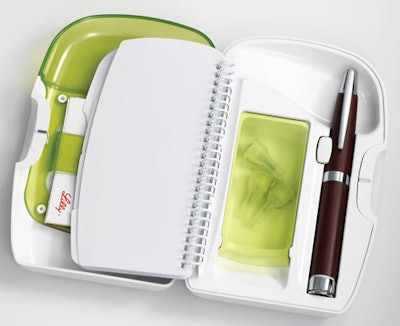
Diabetes affects 246 million people worldwide, and by 2025 the Intl. Diabetes Federation expects that number to reach 380 million. IDF reports that a person dies from diabetes-related causes every 10 seconds. For many diabetics, insulin is a critical treatment, yet there's often an emotional and educational burden for diabetics prescribed with taking the hormone for the first time. An innovative new kit developed by Eli Lilly and Co. and Group 4 incorporates package design to address the issues faced by new insulin users.
“The Insulin Starter Kit is designed to be given out—not sold—by either a nurse or a physician to assist when a patient starts insulin therapy for diabetes,” says David Lock, product brand director for Global Insulin and Insulin Strategy for Indianapolis, IN-based pharmaceutical firm Eli Lilly and Co. “It would typically be administered at a doctor's office, a hospital, or in a diabetes education center.”
The kit with measures approximately 8 in. H x 4 in. W x 1 in. D. It is injection-molded and assembled by plastics contract manufacturer Nypro Healthcare at its facility in Suzhou, China. It is a blend of the thermoplastic acrylonitrile butadiene styrene (ABS) and polycarbonate (PC). The kit contains an instruction pamphlet printed with details on how to take the insulin, where to inject it, how to store the insulin, etc. An inner tray, also injection-molded of PC by Nypro, includes compartments that accommodate needle tips provided by BD Medical and the pen used for injections.
“In the past, starter kits tended to be packaged in corrugated boxes,” says Lock. “We wanted to create a better experience to help the physician or healthcare professional communicate with the patient about getting started on insulin.
“This package is a unique design. It is rounded, so there are no sharp edges anywhere on it. It's completely smooth on the outside, with a soft feel. It is opaque white mostly, with translucent green to allow users to see interior parts through it.”
Scott MacGregor, communications consultant for Eli Lilly and Co., notes that the Insulin Starter Kit was initially launched in Italy and Spain late last year, and is being evaluated for the U.S. market.
Discussing design
How did the package design process evolve between Lilly and Group 4? Lock explains, “There was a search evolving to look at design firms that had a clear understanding of consumer needs in terms of the ability to communicate through the packaging the value of this product in a succinct way. The expertise of Group Four in the pharmaceutical industry on a few projects Lilly had worked on factored into the relationship on this diabetes kit.
“We identified a specific need within our insulin team—to understand some of the challenges between how healthcare professionals and patients talk about starting insulin. Healthcare professionals have limited time in front of patients, and they want to maximize that time to be as effective as possible and communicate the most relevant information. The patient is dealing with a lot of information all at once. So it's important for the package to give them that information, so that when the patient goes back home, he or she will be able to use the product appropriately and effectively to get the benefit that the physician has intended. That was the impetus for the design.”
Meeting multiple needs
Beyond educating patients, Lilly designed the kit package to meet regulatory concerns in different countries. “It's important that our products be labeled appropriately and comply with all the regulatory guidelines,” says Lock.
He states, “Patient safety is at the core of everything we do, and that goes for the design and content of the materials in the kit.” Lock says that Lilly regulatory and safety group personnel are involved in the company's processes used “to make the insulin-filled pens fit in the case so that when the patient gets the case with the pen, it easily pops in and out.
“The marketing group approaches projects as a steward for the patients and of the market needs so we can understand what the physicians are looking for in terms of both their patients' practical and emotional needs,” says Lock. “We apply that knowledge to developing the product and package design.”
Packaging material considerations for the kit, he says, had to answer some key questions, including: How do they feel for the patient and the healthcare professional? Does the kit feel rough or smooth? “Those decisions help enhance the emotional experience,” Lock says. “Materials must relate to patient safety. Are the materials durable and sturdy? Do they present any risks to the patient in terms of interacting with our products in any way? Every decision along the way involves the design of the package.
“Our engineering group talked with Group Four's engineering group to go through the design of our packaging materials, working on CAD drawings, and taking a variety of factors into consideration in determining what materials would be used.
“We tried to minimize the amount of materials in there so as not to overwhelm the physician or the patient and make it intuitive so that when the kit is opened, the patient recognizes the components and how they all fit together.”
Patients keep the kit to store the pens, needles, and information. “We designed it to have durability so patients could use it when traveling, and so that it would last them a long time,” Lock adds.
Lilly does manufacture the glass cartridges in Indianapolis that hold the insulin within the pens. “We have production facilities in Indianapolis, Puerto Rico, France, and locations worldwide to supply different regional markets,” says MacGregor. “The insulin that we provide to the European market comes from our facilities in France and Italy.”
Variable dosing
Another challenge, says Lock, is that dosing of insulin is variable: “A patient may take different doses throughout the day depending on what he or she eats or when he or she exercises, and so the pens allow for variable dosing. But this project revolved around the information that needs to be transferred and shared between physician and patient via this starter kit. We designed the kit to hold the insulin pens already on the market.”
Looking forward, he says, “We haven't made any definitive plans yet in terms of its availability in the U.S.” Global regulatory issues and launch times will factor into that decision.
Lock summarizes: “We put patient safety and regulatory compliance at the top of our list of priorities in package design. This starter kit demonstrates that. It helps the caregiver/physician educate and ensure patients learn how to take insulin safely and effectively. The kit is part of our overall continuum of being innovative and providing value to healthcare professionals and patients as they start on insulin therapy, which can be challenging emotionally and in practical terms. We want the package to help them out as much as possible to better control diabetes and improve their health outcomes.”
“The Insulin Starter Kit is designed to be given out—not sold—by either a nurse or a physician to assist when a patient starts insulin therapy for diabetes,” says David Lock, product brand director for Global Insulin and Insulin Strategy for Indianapolis, IN-based pharmaceutical firm Eli Lilly and Co. “It would typically be administered at a doctor's office, a hospital, or in a diabetes education center.”
The kit with measures approximately 8 in. H x 4 in. W x 1 in. D. It is injection-molded and assembled by plastics contract manufacturer Nypro Healthcare at its facility in Suzhou, China. It is a blend of the thermoplastic acrylonitrile butadiene styrene (ABS) and polycarbonate (PC). The kit contains an instruction pamphlet printed with details on how to take the insulin, where to inject it, how to store the insulin, etc. An inner tray, also injection-molded of PC by Nypro, includes compartments that accommodate needle tips provided by BD Medical and the pen used for injections.
“In the past, starter kits tended to be packaged in corrugated boxes,” says Lock. “We wanted to create a better experience to help the physician or healthcare professional communicate with the patient about getting started on insulin.
“This package is a unique design. It is rounded, so there are no sharp edges anywhere on it. It's completely smooth on the outside, with a soft feel. It is opaque white mostly, with translucent green to allow users to see interior parts through it.”
Scott MacGregor, communications consultant for Eli Lilly and Co., notes that the Insulin Starter Kit was initially launched in Italy and Spain late last year, and is being evaluated for the U.S. market.
Discussing design
How did the package design process evolve between Lilly and Group 4? Lock explains, “There was a search evolving to look at design firms that had a clear understanding of consumer needs in terms of the ability to communicate through the packaging the value of this product in a succinct way. The expertise of Group Four in the pharmaceutical industry on a few projects Lilly had worked on factored into the relationship on this diabetes kit.
“We identified a specific need within our insulin team—to understand some of the challenges between how healthcare professionals and patients talk about starting insulin. Healthcare professionals have limited time in front of patients, and they want to maximize that time to be as effective as possible and communicate the most relevant information. The patient is dealing with a lot of information all at once. So it's important for the package to give them that information, so that when the patient goes back home, he or she will be able to use the product appropriately and effectively to get the benefit that the physician has intended. That was the impetus for the design.”
Meeting multiple needs
Beyond educating patients, Lilly designed the kit package to meet regulatory concerns in different countries. “It's important that our products be labeled appropriately and comply with all the regulatory guidelines,” says Lock.
He states, “Patient safety is at the core of everything we do, and that goes for the design and content of the materials in the kit.” Lock says that Lilly regulatory and safety group personnel are involved in the company's processes used “to make the insulin-filled pens fit in the case so that when the patient gets the case with the pen, it easily pops in and out.
“The marketing group approaches projects as a steward for the patients and of the market needs so we can understand what the physicians are looking for in terms of both their patients' practical and emotional needs,” says Lock. “We apply that knowledge to developing the product and package design.”
Packaging material considerations for the kit, he says, had to answer some key questions, including: How do they feel for the patient and the healthcare professional? Does the kit feel rough or smooth? “Those decisions help enhance the emotional experience,” Lock says. “Materials must relate to patient safety. Are the materials durable and sturdy? Do they present any risks to the patient in terms of interacting with our products in any way? Every decision along the way involves the design of the package.
“Our engineering group talked with Group Four's engineering group to go through the design of our packaging materials, working on CAD drawings, and taking a variety of factors into consideration in determining what materials would be used.
“We tried to minimize the amount of materials in there so as not to overwhelm the physician or the patient and make it intuitive so that when the kit is opened, the patient recognizes the components and how they all fit together.”
Patients keep the kit to store the pens, needles, and information. “We designed it to have durability so patients could use it when traveling, and so that it would last them a long time,” Lock adds.
Lilly does manufacture the glass cartridges in Indianapolis that hold the insulin within the pens. “We have production facilities in Indianapolis, Puerto Rico, France, and locations worldwide to supply different regional markets,” says MacGregor. “The insulin that we provide to the European market comes from our facilities in France and Italy.”
Variable dosing
Another challenge, says Lock, is that dosing of insulin is variable: “A patient may take different doses throughout the day depending on what he or she eats or when he or she exercises, and so the pens allow for variable dosing. But this project revolved around the information that needs to be transferred and shared between physician and patient via this starter kit. We designed the kit to hold the insulin pens already on the market.”
Looking forward, he says, “We haven't made any definitive plans yet in terms of its availability in the U.S.” Global regulatory issues and launch times will factor into that decision.
Lock summarizes: “We put patient safety and regulatory compliance at the top of our list of priorities in package design. This starter kit demonstrates that. It helps the caregiver/physician educate and ensure patients learn how to take insulin safely and effectively. The kit is part of our overall continuum of being innovative and providing value to healthcare professionals and patients as they start on insulin therapy, which can be challenging emotionally and in practical terms. We want the package to help them out as much as possible to better control diabetes and improve their health outcomes.”






















